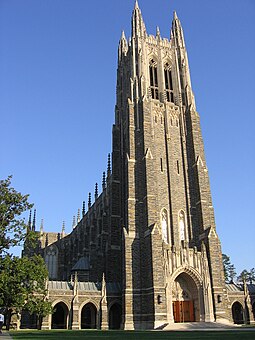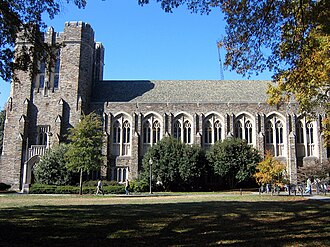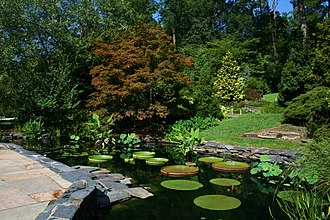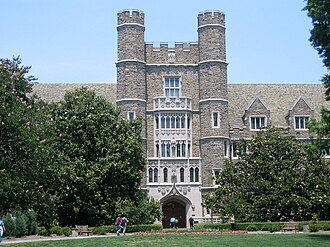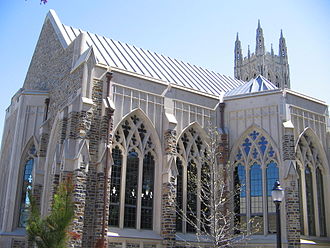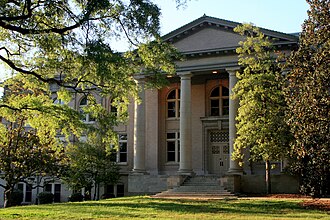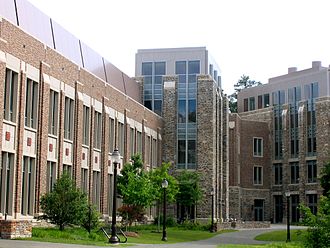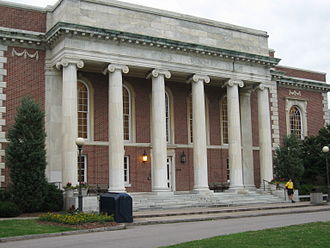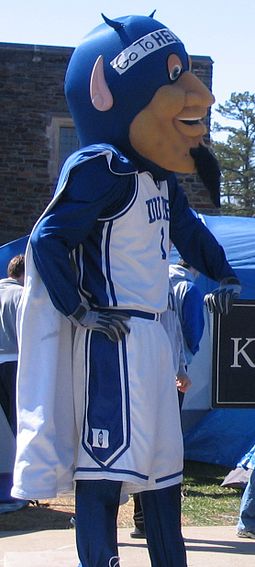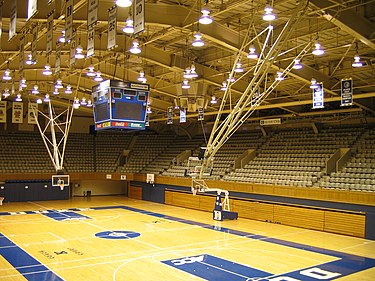Duke University
| Duke University | |
|---|---|
 | |
| Motto | Eruditio et Religio (Latin)[1] |
| Motto in English | Knowledge and Faith[2] |
| Established | 1838 |
| Type | Private |
| Religious affiliation | United Methodist Church ties, but nonsectarian and independent[3] |
| Endowment | $6.0 billion (The university is also the primary beneficiary of the independent $3 billion Duke Endowment)[4] |
| President | Richard H. Brodhead |
| Academic staff | 3,262[4] |
| Admin. staff |
|
| Students | 14,591 (Fall 2012)[4] |
| Undergraduates | 6,484 (Fall 2012)[4] |
| Postgraduates | 8,107 (Fall 2012)[4] |
| Location | Durham, North Carolina, United States 36°0′4″N 78°56′20″W / 36.00111°N 78.93889°W / 36.00111; -78.93889Coordinates: 36°0′4″N 78°56′20″W / 36.00111°N 78.93889°W / 36.00111; -78.93889 |
| Campus |
|
| Former names |
|
| Colors | |
| Athletics | NCAA Division I FBS; ACC 26 varsity teams |
| Nickname | Blue Devils |
| Affiliations | AAU, COFHE, 568 Group, URA, CDIO |
| Website | duke.edu |
 | |
Duke University is a private research university located in Durham, North Carolina, United States. Founded by Methodists and Quakers in the present-day town of Trinity in 1838, the school moved to Durham in 1892.[6] In 1924, tobacco and electric power industrialist James B. Duke established The Duke Endowment, at which time the institution changed its name to honor his deceased father, Washington Duke.
The university has "historical, formal, on-going, and symbolic ties" with the United Methodist Church whereby 24 of 36 University Trustees are elected at the United Methodist Church conference,[7] but is a nonsectarian and independent institution.[3][8][9][10] Duke's research expenditures in the 2010 fiscal year topped $983 million, the fifth largest figure in the nation.[11] Competing in the Atlantic Coast Conference, Duke's athletic teams—known as the Blue Devils—have captured 13 team national championships, including four by its high profile men's basketball team.
The university's campus spans over 8,600 acres (35 km2) on three contiguous campuses in Durham as well as a marine lab in Beaufort. Duke's main campus—designed largely by African American architect Julian Abele—incorporates Gothic architecture with the 210-foot (64 m) Duke Chapel at the campus' center and highest point of elevation. The forest environs surrounding parts of the campus belie the University's proximity to downtown Durham. Construction projects have updated both the freshmen-populated Georgian-style East Campus and the main Gothic-style West Campus, as well as the adjacent Medical Center over the past five years.
In its 2014 edition, U.S. News & World Report ranked the university's undergraduate program tied for seventh among national universities.[12] Forbes magazine ranked Duke 7th in the world on its list of 'power factories' in 2012.[13]
Contents
[show]
History of Duke[edit]
Beginnings[edit]
Duke started in 1838 as Brown's Schoolhouse, a private subscription school founded in Randolph County in the present-day town of Trinity.[14] Organized by the Union Institute Society, a group of Methodists and Quakers, Brown's Schoolhouse became the Union Institute Academy in 1841 when North Carolina issued a charter. The academy was renamed Normal College in 1851 and then Trinity College in 1859 because of support from the Methodist Church.[14] In 1892 Trinity moved to Durham, largely due to generosity from Julian S. Carr and Washington Duke, powerful and respected Methodists who had grown wealthy through the tobacco and electrical industries.[6] Carr donated land in 1892 for the original Durham campus, which is now known as East Campus. At the same time, Washington Duke gave the school $85,000 for an initial endowment and construction costs—later augmenting his generosity with three separate $100,000 contributions in 1896, 1899, and 1900—with the stipulation that the college "open its doors to women, placing them on an equal footing with men."[15]
In 1924 Washington Duke's son, James B. Duke, established The Duke Endowment with a $40 million trust fund. Income from the fund was to be distributed to hospitals, orphanages, the Methodist Church, and four colleges (including Trinity College). William Preston Few, the president of Trinity at the time, insisted that the institution be renamed Duke University to honor the family's generosity and to distinguish it from the myriad of other colleges and universities carrying the "Trinity" name. At first, James B. Duke thought the name change would come off as self-serving, but eventually he accepted Few's proposal as a memorial to his father.[6] Money from the endowment allowed the University to grow quickly. Duke's original campus, East Campus, was rebuilt from 1925 to 1927 with Georgian-style buildings. By 1930, the majority of the Collegiate Gothic-style buildings on the campus one mile (1.6 km) west were completed, and construction on West Campus culminated with the completion of Duke Chapel in 1935.[16]
Expansion and growth[edit]
Engineering, which had been taught since 1903, became a separate school in 1939. In athletics, Duke hosted and competed in the only Rose Bowl ever played outside California in Wallace Wade Stadium in 1942.[17] During World War II, Duke was one of 131 colleges and universities nationally that took part in the V-12 Navy College Training Program which offered students a path to a Navy commission.[18] In 1963 the Board of Trustees officially desegregated the undergraduate college.[19] Increased activism on campus during the 1960s prompted Dr. Martin Luther King, Jr. to speak at the University in November 1964 on the progress of the civil rights movement. Terry Sanford, the former governor of North Carolina, was elected president of the university in 1969, propelling the Fuqua School of Business's opening, the William R. Perkins library completion, and the founding of the Institute of Policy Sciences and Public Affairs (now the Sanford School of Public Policy). The separate Woman's College merged back with Trinity as the liberal arts college for both men and women in 1972. Beginning in the 1970s, Duke administrators began a long-term effort to strengthen Duke's reputation both nationally and internationally. Interdisciplinary work was emphasized, as was recruiting minority faculty and students. During this time it also became the birthplace of the first Physician Assistant degree program in the United States.[20][21][22] Duke University Hospital was finished in 1980 and the student union building was fully constructed two years later. In 1986 the men's soccer team captured Duke's first National Collegiate Athletic Association (NCAA) championship, and the men's basketball team followed shortly thereafter with championships in 1991 and 1992, then again in 2001 and 2010.
Recent history[edit]
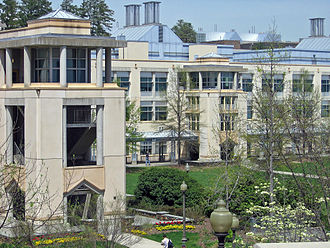
Duke's growth and academic focus have contributed to continuing the university's reputation as an academic and research powerhouse.[24]
Construction continued on campus in the 1990s, with the 314,000-square-foot (29,200 m2) Levine Science Research Center (LSRC) opening in 1994 to house interdisciplinary research. Similar projects have updated both the freshmen-housed East Campus and the main West Campus, as well as the adjacent Medical Center, in the past two decades.
In 2013 construction projects included transforming buildings like Gross Hall and Baldwin Auditorium, plus new construction such as the Events Pavilion. About 125,000 square feet was being updated at Gross Hall, including new lighting and windows and a skylight. Baldwin's upgrades include a larger stage, more efficient air conditioning for performers and audience and enhanced acoustics that will allow for the space to be "tuned" to each individual performance. The 25,000-square-foot Events Pavilion was set to start serving students in fall 2013. It will serve as temporary dining space while the West Campus Union undergoes major renovations.
In 1998 President Nan Keohane initiated a five-year $1.5 billion "Campaign for Duke" fundraising effort. Edmund T. Pratt, Jr. ('47) endowed the Pratt School of Engineering with a $35 million gift in 1999. The Campaign for Duke ended in 2003 with $2.36 billion raised, making it the fifth largest campaign in the history of American higher education.[25]
In late 2012, Duke announced the launch of a $3.25 billion fundraising campaign. "Duke Forward: Partnering for the Future," will support priorities across Duke's 10 schools, Duke Medicine and a range of university programs.
Three students were named Rhodes Scholars in both 2002 and 2006, a number surpassed only by Harvard in 2002 and the United States Military Academy in 2006.[26][27] Overall, Duke has produced 43 Rhodes Scholars through 2011, including 22 in the 21-year period between 1990 to 2011.
Figures from the 2010 fiscal year show research expenditures surpassed the $983 million mark.[11][28]
In August 2005, Duke established a partnership with the National University of Singapore to develop a joint medical program, which had its first entering class in 2007.[29] Duke, in partnership with the city of Kunshan, China and Wuhan University, is forming a new joint venture university to be named Duke- Kunshan University (DKU).[30]
The first working demonstration of an invisibility cloak was unveiled by Duke researchers in October 2006.[31] Another notable event in 2006 occurred when three lacrosse team members were falsely accused of rape. Charges against the players were later dropped, Durham district attorney Mike Nifong was disbarred, and the accused were declared innocent by the state's attorney general. The incident garnered significant media attention.[32]
Campus[edit]
Duke University owns 220 buildings on 8,610 acres (34.8 km2) of land, which includes the 7,200 acres (29 km2) Duke Forest.[4] The campus is divided into four main areas: West, East, and Central campuses and the Medical Center, which are all connected via a free bus service. on the Atlantic coast in Beaufort, Duke owns 15 acres (61,000 m2) as part of its marine lab. one of the major public attractions on the main campus is the 55-acre (220,000 m2) Sarah P. Duke Gardens, established in the 1930s.[4]
Duke students often refer to the campus as "the Gothic Wonderland," a nickname referring to the Collegiate Gothic architecture of West Campus.[33][34] Much of the campus was designed by Julian Abele, one of the first prominent African-American architects and the chief designer in the offices of architect Horace Trumbauer.[35] The residential quadrangles are of an early and somewhat unadorned design, while the buildings in the academic quadrangles show influences of the more elaborate late French and Italian styles. The freshmen campus (East Campus) is composed of buildings in the Georgian architecture style.[4]
The stone used for West Campus has seven primary colors and seventeen shades of color.[36] The university supervisor of planning and construction wrote that the stone has "an older, more attractive antique effect" and a "warmer and softer coloring than the Princeton stone" that gave the university an "artistic look."[36] James B. Duke initially suggested the use of stone from a quarry in Princeton, New Jersey, but later amended the plans to purchase a local quarry in Hillsborough to reduce costs.[36] Duke Chapel stands at the center of West Campus on the highest ridge. Constructed from 1930 to 1935, the chapel seats 1,600 people and, at 210 feet (64 m) is one of the tallest buildings in Durham County.[37]
From February 2001 to November 2005, Duke spent $835 million on 34 major construction projects as part of a five-year strategic plan, "Building on Excellence."[38] Completed projects since 2002 include major additions to the business, law, nursing, and divinity schools, a new library, an art museum, a football training facility, two residential buildings, an engineering complex, a public policy building, an eye institute, two genetic research buildings, a student plaza, the French Family Science Center, and two new medical-research buildings.[39]
Libraries and museums[edit]
With more than six million volumes, the Duke University Library System is one of the ten largest private research university library systems in the U.S. and is 22nd largest among members of the Association of Research Libraries.[40] In addition to millions of books, there are 17.7 million manuscripts, 1.2 million public documents, and tens of thousands of films and videos.[41]
The William R. Perkins Library system comprises the Perkins Library complex (Perkins Library, Bostock Library, Rare Book, Manuscript, and Special Collections Library and University Archives), Lilly Library (which houses materials on fine arts, philosophy, film and video, and performing arts), the Music Library, and the Pearse Memorial Library (located at the Marine Lab).[42] Besides the main William R. Perkins Library complex, the university library system also includes the separately-administered Ford (business), Divinity School, Goodson Law, and Medical Center libraries.[43]
Duke's art collections are housed at the Nasher Museum of Art on Central Campus. The museum was designed by Rafael Viñoly and is named for Duke alumnus and art collector Raymond Nasher. The museum opened in 2005 at a cost of over $23 million and contains over 13,000 works of art, including works by William Cordova, Marlene Dumas, Olafur Eliasson, David Hammons, Barkley L. Hendricks, Christian Marclay, Kerry James Marshall, D Alma Thomas, Hank Willis Thomas, Bob Thompson, Kara Walker, Andy Warhol, Carrie Mae Weems, Ai Weiwei, Fred Wilson and Lynette Yiadom Boakye.[44]
West, East, and Central Campuses[edit]
West Campus, considered the main campus of the University, houses the majority of the sophomores, along with some juniors and seniors.[45] Most of the academic and administrative centers are located there. Main West Campus, with Duke Chapel at its center, contains the majority of residential quads to the south, while the main academic quad, library, and Medical Center are to the north. The campus, spanning 720 acres (2.9 km2), includes Science Drive, which is the location of science and engineering buildings. Most of the campus eateries and sports facilities—including the historic basketball stadium, Cameron Indoor Stadium—are on West Campus.[4][46]
East Campus, the original location of Duke after it moved to Durham,[47] functions as a freshman campus as well as the home of several academic departments. Since the 1995–96 academic year, all freshmen—and only freshmen, except for upperclassmen serving as Resident Assistants—have lived on East Campus, to build class unity. The campus encompasses 97 acres (390,000 m2) and is 1.5 miles (2.4 km) from West Campus.[4] The Art History, History, Literature, Music, Philosophy, and Women's Studies Departments are housed on East.[47] Programs such as dance, drama, education, film, and the University Writing Program reside on East. The self-sufficient East Campus contains the freshman residence halls, a dining hall, coffee shop, post office, Lilly Library, Baldwin Auditorium, a theater, Brodie Gym, tennis courts, several disc golf baskets, and a walking track as well as several academic buildings.[47] Separated from downtown by a short walk, the area was the site of the Women's College from 1930 to 1972.[47]
Central Campus, consisting of 122 acres (0.49 km2) between East and West campuses, houses around 850 sophomores, juniors, and seniors, as well as around 200 professional students in double or quadruple apartments.[48] It is home to the Nasher Museum of Art, the Freeman Center for Jewish Life, the Center for Muslim Life, the Duke Police Department, the Duke Office of Disability Management, a Ronald McDonald House, and administrative departments such as Duke Residence Life and Housing Services. Central Campus has several recreation and social facilities such as basketball courts, tennis courts, a sand volleyball court, barbecue grills and picnic shelters, a general gathering building called Devil's Den, the Mill Village, and a convenience store called Uncle Harry's.[48]
Since 2005, there has been a long-term plan in place to restructure Central Campus over the subsequent 20 to 50 years.[49] The idea is to develop an "academic village" as a key center for the Duke community.[50] This academic village will provide living arrangements for undergraduate, graduate, and professional students and some faculty, plus dining, recreation, and academic support spaces while serving as a living laboratory for sustainability.[49][51]
Key places[edit]
Duke Forest, established in 1931, consists of 7,200 acres (29 km2) in six divisions, just west of West Campus.[4] The largest private research forest in North Carolina and one of the largest in the nation,[52] the Duke Forest demonstrates a variety of forest stand types and silvicultural treatments. Duke Forest is used extensively for research and includes the Aquatic Research Facility, Forest Carbon Transfer and Storage (FACTS-I) research facility, two permanent towers suitable for micrometerological studies, and other areas designated for animal behavior and ecosystem study.[53] More than 30 miles (48 km) of trails are open to the public for hiking, cycling, and horseback riding.[54]
The Duke Lemur Center, located inside the Duke Forest, is the world's largest sanctuary for rare and endangered prosimian primates.[55] Founded in 1966, the Duke Lemur Center spans 85 acres (34.4 ha) and contains nearly 300 animals of 25 different species of lemurs, galagos and lorises.[56]
The Sarah P. Duke Gardens, established in the early 1930s, is situated between West Campus and the apartments of Central Campus. The gardens occupy 55 acres (22 ha), divided into four major sections:[57] the original Terraces and their surroundings; the H.L. Blomquist Garden of Native Plants, devoted to flora of the Southeastern United States; the W.L. Culberson Asiatic Arboretum, housing plants of Eastern Asia, as well as disjunct species found in Eastern Asia and Eastern North America; and the Doris Duke Center Gardens. There are five miles (8 km) of allées and paths throughout the gardens.[57]
Duke University Medical Center, bordering Duke's West Campus northern boundary, combines one of the top-rated hospitals[58] and one of the top-ranked medical schools[59] in the U.S. Founded in 1930, the Medical Center occupies 8 million square feet (700,000 m²) in 99 buildings on 210 acres (85 ha).[60]
Duke University Marine Laboratory, located in the town of Beaufort, North Carolina, is also technically part of Duke's campus. The marine lab is situated on Pivers Island on the Outer Banks of North Carolina, 150 yards (140 m) across the channel from Beaufort. Duke's interest in the area began in the early 1930s and the first buildings were erected in 1938.[61] The resident faculty represent the disciplines of oceanography, marine biology, marine biomedicine, marine biotechnology, and coastal marine policy, and management. The Marine Laboratory is a member of the National Association of Marine Laboratories.[61] In May 2012, Duke's Board of Trustees approved construction of a $6.75 million Orrin Pilkey Marine Sciences and Conservation Genetics Center at the Duke Marine Lab. Groundbreaking for the approximately 12,000-square-foot facility will take place in July 2012, with an anticipated opening in fall 2013.
Academics[edit]
Duke's student body consists of 6,484 undergraduates and 8,107 graduate and professional students (as of fall 2012).[4] The university has "historic and symbolic ties to the Methodist Church but it always has been independent in its governance."[9][10][62]
Admission to Duke is highly selective; Duke received 31,785 applications in 2013, and admitted 11.6% of applicants.[63] According to The Huffington Post, Duke was the tenth toughest university in the United States to get into based on admissions data from 2010.[64] The yield rate (the percentage of accepted students who choose to attend the university) was approximately 42%.[65] For the class of 2015, 90% of enrolled students ranked in the top 10% of their high school classes; 97% ranked in the top quarter.[66] The middle 50% range of SAT scores for the freshman students enrolled in Fall 2011 is 660-750 for verbal/critical reading, 690-780 for math, and 670-770 for writing, while the ACT Composite range is 30–34.[66]
Duke University has two schools for undergraduates: Trinity College of Arts and Sciences and Pratt School of Engineering.[67]
| Undergraduate | Graduate | U.S. Census[69] | |
|---|---|---|---|
| African American | 10% | 5% | 12.1% |
| Asian American | 21% | 9% | 4.3% |
| Non-Hispanic White American |
47% | 53% | 68% |
| Hispanic American | 6% | 3% | 14.5% |
| Other/Unknown/ International |
16% | 30% | N/A |
From 2001 to 2011, Duke has had the sixth highest number of Fulbright, Rhodes, Truman, and Goldwater scholarships in the nation among private universities.[70][71][72][73] The University practices need-blind admissions and meets 100% of admitted students' demonstrated need. About 50 percent of all Duke students receive some form of financial aid, which includes need-based aid, athletic aid, and merit aid. The average need-based grant for the 2011–2012 academic year was more than $37,400.[4] Roughly 60 merit-based scholarships are also offered, including the Angier B. Duke Memorial Scholarship, awarded for academic excellence. Other scholarships are geared toward students in North Carolina, African-American students, and high-achieving students requiring financial aid.[74]
Duke's endowment had a market value of $6.0 billion in the fiscal year that ended June 30, 2013.[4] The University's special academic facilities include an art museum, several language labs, the Duke Forest, the Duke Herbarium, a lemur center, a phytotron, a free electron laser, a nuclear magnetic resonance machine, a nuclear lab, and a marine lab. Duke is a leading participant in the National Lambda Rail Network and runs a program for gifted children known as the Talent Identification Program.[75][76]
Graduate profile[edit]
In 2009, the School of Medicine received 5,166 applications[77] and accepted approximately 4% of them,[78] while the average GPA and MCAT scores for accepted students from 2002 through 2009 were 3.74 and 34, respectively.[79][80] The School of Law accepted approximately 13% of its applicants for the Class of 2014, while enrolling students had a median GPA of 3.75 and median LSAT of 170.[81]
The University's graduate and professional schools include the Graduate School, the Pratt School of Engineering, the Nicholas School of the Environment, the School of Medicine, the Duke-NUS Graduate Medical School, the School of Nursing, the Fuqua School of Business, the School of Law, the Divinity School, and the Sanford School of Public Policy.[82]
Undergraduate curriculum[edit]
Duke offers 46 arts and sciences majors, four engineering majors, 49 Minors (including two in engineering) and Program II, which allows students to design their own interdisciplinary major in arts & sciences, and IDEAS, which allows students to design their own engineering major.[83] Twenty-four certificate programs also are available.[83] Students pursue a major, and can pursue a combination of a total of up to three including minors, certificates, and/or
a second major. Eighty percent of undergraduates enroll in the Trinity College of Arts and Sciences, while the rest are in the Pratt School of Engineering.[84]
Trinity's curriculum operates under the revised version of "Curriculum 2000."[85] It ensures that students are exposed to a variety of "areas of knowledge" and "modes of inquiry." The curriculum aims to help students develop critical faculties and judgment by learning how to access, synthesize, and communicate knowledge effectively. The intent is to assist students in acquiring perspective on current and historical events, conducting research and solving problems, and developing tenacity and a capacity for hard and sustained work.[85] Freshmen can elect to participate in the FOCUS Program, which allows students to engage in an interdisciplinary exploration of a specific topic in a small group setting.[86]
Pratt's curriculum is narrower in scope, but still accommodates double majors in a variety of disciplines. The school emphasizes undergraduate research—opportunities for hands-on experiences arise through internships, fellowship programs, and the structured curriculum. More than 27 percent of Pratt undergraduates study abroad,[87] small compared to about half of Trinity undergraduates, but much larger than the recent national average for engineering students (3.2%).[88][89]
Research[edit]
In fiscal year 2011, Duke University research expenditures were $1,022,207,000, making it the 2nd highest among private institutions and 5th overall in the rankings, according to the National Science Foundation. In the 2013 fiscal year, Duke University Medical Center received $270 million of NIH funding (exclusive of contracts and Economic Stimulus Program awards).
Throughout the school's history, Duke researchers have made breakthroughs, including the biomedical engineering department's development of the world's first real-time, three-dimensional ultrasound diagnostic system and the first engineered blood vessels.[90] In the mechanical engineering department, Adrian Bejan developed the constructal theory, which explains the shapes that arise in nature. Duke has pioneered studies involving nonlinear dynamics, chaos, and complex systems in physics. In May 2006 Duke researchers mapped the final human chromosome, which made world news as the Human Genome Project was finally complete.[91] Reports of Duke researchers' involvement in new AIDS vaccine research surfaced in June 2006.[92] The biology department combines two historically strong programs in botany and zoology, while one of the divinity school's leading theologians is Stanley Hauerwas, whom Time named "America's Best Theologian" in 2001.[93] The graduate program in literature boasts several internationally renowned figures, including Fredric Jameson,[94] Michael Hardt,[95] and Rey Chow, while philosophers Robert Brandon and Lakatos Award-winner Alexander Rosenberg contribute to Duke's ranking as the nation's best program in philosophy of biology, according to the Philosophical Gourmet Report.[96]
Rankings[edit]
| University rankings | |
|---|---|
| National | |
| ARWU[97] | 23 |
| Forbes[98] | 15 |
| U.S. News & World Report[99] | 7 |
| Washington Monthly[100] | 26 |
| Global | |
| ARWU[101] | 31 |
| QS[102] | 23 |
| Times[103] | 17 |
In the 2014 U.S. News & World Report ranking of undergraduate programs at doctoral granting institutions, Duke was tied for 7th.[12] In the past twenty years, U.S. News & World Report has placed Duke as high as 3rd and as low as 10th.[104] In 2013, Duke was ranked 23rd in the world in the QS World University Rankings[105] and 17th in the world by the Times Higher Education World University Rankings.[106] Duke was ranked the 14th-best university in the world by Newsweek[107] and 31st best globally by Shanghai Jiao Tong University's Academic Ranking of World Universities (ARWU) in 2013, focusing on quality of scientific research and the number of Nobel Prizes.[108] The Wall Street Journal ranked Duke sixth (fifth among universities) in its "feeder" rankings in 2006, analyzing the percentage of undergraduates that enroll in what it considers the top five medical, law, and business schools.[109] The 2010 report by the Center for Measuring University Performance puts Duke at 6th in the nation.[24] The 2011 Global Employability Ranking as published by The New York Times surveyed hundreds of chief executives and chairmen from around the world and asked them to select the best universities from which they recruited, placed Duke at 13th in the world and 9th in the country.[110][111] In 2005, Duke enrolled 117 National Merit Scholars, the 6th university in rank by number.[112] Duke ranks 5th among national universities to have produced Rhodes, Marshall, Truman, Goldwater, and Udall Scholars.[113] According to the 2011 Princeton Review's survey on "Top Dream Colleges" among parents, Duke ranked as the 6th dream university.[114] Kiplinger's 50 Best Values in Private Universities 2013–14 ranks Duke at 5th best overall after taking financial aid into consideration.[115] According to a study by Forbes, Duke ranks 11th among universities that have produced billionaires and 1st among universities in the South.[116][117] A survey by the Journal of Blacks in Higher Education in 2002 ranked Duke as the #1 university in the country in regard to the integration of African American students and faculty.[118] Data from Payscale.com in 2012 shows Duke graduates earning the 6th highest median salaries among national universities in the US.[citation needed] According to a poll of recruiters conducted by The Wall Street Journal, Duke ranks 2nd in terms of producing the best graduates who have received either a marketing or liberal arts degree. Collegeatlas.com ranks the undergraduate liberal arts program at Duke number 3 in the nation, the ranking incorporates both research universities as well as liberal arts colleges in the United States.
In U.S. News & World Report's "America's Best Graduate Schools 2014," Duke's medical school ranked 8th for research.[119] The hospital was ranked 8th in the nation by the 2011–2012 U.S. News & World Report Health Rankings of Best Hospitals in America.[120] The School of Law was ranked 11th in 2014 by the same publication, while law recruiters ranked the program 8th in the country.[119][121][122][123] Duke's nursing school ranked 7th in U.S. News & World Report's 2014 rankings,[119] while the Sanford School of Public Policy ranked 16th in 2014 for national public affairs programs and 6th for public policy analysis.[124][125] Among business schools in the United States, the Fuqua School of Business was ranked 4th for its Executive M.B.A. program, 3rd for marketing, 8th for management, and 11th overall by U.S. News & World Report in 2014, while BusinessWeek ranked its full-time MBA program 6th in the nation in 2013.[126][127] The graduate program for the Pratt School of Engineering was ranked 28th while the biomedical engineering program was ranked 3rd by U.S. News & World Report.[128] Taking the U.S. News & World Report Professional School Rankings in 2008 based on Mean Reputation Score, Duke ranks 7th among national universities.[129] Times Higher Education ranked the mathematics department tenth in the world in 2011.[130] Duke's graduate level specialties that are ranked among the top ten in the nation include areas in the following departments: biological sciences, medicine, nursing, engineering, law, business, English, history, physics, statistics, public affairs, physician assistant (ranked #1), clinical psychology, political science, and sociology.[131] In 2007, Duke was ranked 22nd in the world by Wuhan University's Research Center for Chinese Science Evaluation. The ranking was based on journal article publication counts and citation frequencies in over 11,000 academic journals from around the world. A 2012 study conducted by academic analytics ranks Duke fourth in the nation (behind only Harvard, Stanford, and MIT) in terms of faculty productivity.[132] The study takes into consideration books and journal articles published, grants, honors and awards received, and how often faculty members are cited in their specialties' literature. In 2013, Duke Law ranked 6th in Forbes magazine's ranking of law schools whose graduates earn the highest starting salaries.[133] The data utilized by Forbes was generated by Payscale.com, and the ranking also showed that Duke Law grads earn the second highest mid-career salaries in the country. In 2013, Duke's Fuqua School of Business was ranked 6th in terms of graduate starting salaries by U.S. News & World Report. In the same year, a ranking compiled by the University of Texas at Dallas ranked Fuqua 5th in the world based on the research productivity of its faculty. The MEM (Masters in Engineering Management) program has been ranked 3rd in the world by Eduniversal [134] In 2013, Forbes ranked Duke 4th in the nation in terms of return on investment (ROI). The ranking used alumni giving as a criteria to determine which private colleges offer the best returns.[135] In the same year, Above the Law ranked Duke Law 6th in the nation in its ranking of law schools based on employment outcomes [136] In 2012, Business Insider ranked Duke 10th in its ranking of the smartest colleges in America. The ranking was based on data collected by lumosity, a cognitive training website [137] In 2013, Business Insider ranked Duke's Fuqua School of Business 5th in the world based on an extensive survey of hiring professionals [138] In the same year, Forbes magazine ranked Fuqua 8th in the country based on return on investment.
Student life[edit]
Residential life[edit]
Duke requires its students to live on campus for the first three years of undergraduate life, except for a small percentage of second semester juniors who are exempted by a lottery system.[45] This requirement is justified by the administration as an effort to help students connect more closely with one another and sustain a sense of belonging within the Duke community.[139] Thus, 85% of undergraduates live on campus.[140] All freshmen are housed in one of 14 residences on East Campus. These buildings range in occupancy size from 50 (Epworth—the oldest residence hall, built in 1892 as "the Inn") to 190 residents (Gilbert-Addoms).[141][142] Most of these are in the Georgian style typical of the East Campus architecture. Although the newer residence halls differ in style, they still relate to East's Georgian heritage. Learning communities connect the residential component of East Campus with students of similar academic and social interests.[143] Similarly, students in FOCUS, a first-year program that features courses clustered around a specific theme, live together in the same residence hall as other students in their cluster.[144]
Sophomores, juniors and seniors can choose to reside on either West or Central campuses, although the majority of undergraduate seniors choose to live off campus.[145][146] West Campus contains six quadrangles—the four along "Main" West were built in 1930s, while two newer ones have since been added. Central Campus provides housing for over 1,000 students in apartment buildings.[147] All housing on West and Central is organized into about 80 "houses"—sections of residence halls or clusters of apartments—to which students can return each year. House residents create their house identities. There are houses of unaffiliated students, as well as wellness houses and living-learning communities that adopt a theme such as the arts or foreign languages. There are also numerous "selective living groups" on campus for students wanting self-selected living arrangements. SLGs are residential groups similar to fraternities or sororities, except they are generally co-ed and unaffiliated with any national organization. Many of them also revolve around a particular interest such as entrepreneurship, civic engagement or African-American or Asian culture. Fifteen fraternities and nine sororities also are housed on campus, primarily on Central. Most of the non-fraternity selective living groups are coeducational.[148]
Greek and social life[edit]
About 30% of undergraduate men and about 40% of undergraduate women at Duke are members of fraternities and sororities.[140] Most of the 15 Interfraternity Council recognized fraternity chapters live in sections within the residence halls. Starting in 2012, the nine Panhellenic Association sorority chapters decided to live in houses (clusters of apartments) on Central Campus. Not all sorority members live with their chapters, though, as membership exceeds house space. Eight National Pan-Hellenic Council (historically African American) fraternities and sororities also hold chapters at Duke.[149] In addition, there are seven other fraternities and sororities that are a part of the Inter-Greek Council, the multicultural Greek umbrella organization.[150] Duke also has 19 Selective Living Groups, or SLGs, on campus for students seeking informal residential communities often built around themes.[151] SLGs are residential groups similar to fraternities or sororities, except they are generally co-ed and unaffiliated with any national organizations.[152] Fraternity chapters and SLGs frequently host social events in their residential sections, which are often open to non-members.[153]
In the late-1990s, a new keg policy was put into effect that requires all student groups to purchase kegs through Duke Dining Services. According to administrators, the rule change was intended as a way to ensure compliance with alcohol consumption laws as well as to increase on-campus safety.[154] Some students saw the administration's increasingly strict policies as an attempt to alter social life at Duke.[155] As a result, off-campus parties at rented houses became more frequent in subsequent years as a way to avoid Duke policies. Many of these houses were situated in the midst of family neighborhoods, prompting residents to complain about excessive noise and other violations. Police have responded by breaking up parties at several houses, handing out citations, and occasionally arresting party-goers.[156] In the mid-to-late 2000s (decade), the administration made a concerted effort to help students re-establish a robust, on-campus social life and has worked with numerous student groups, especially the Duke University Union, to feature a wide array of events and activities. In March 2006, the university purchased 15 houses in the Trinity Park area that Duke students had typically rented and subsequently sold them to individual families in an effort to encourage renovations to the properties and to reduce off-campus partying in the midst of residential neighborhoods.[157][158]
Duke athletics, particularly men's basketball, traditionally serves as a significant component of student life. Duke's students have been recognized as some of the most creative and original fans in all of collegiate athletics.[159] Students, often referred to as Cameron Crazies, show their support of the men's basketball team by "tenting" for home games against key Atlantic Coast Conference rivals, especially University of North Carolina at Chapel Hill (UNC).[160] Because tickets to all varsity sports are free to students, they line up for hours before each game, often spending the night on the sidewalk. For a mid-February game against UNC, some of the most eager students might even begin tenting before spring classes begin.[161] The total number of participating tents is capped at 100 (each tent can have up to 12 occupants), though interest is such that it could exceed that number if space permitted.[162] Tenting involves setting up and inhabiting a tent on the grass near Cameron Indoor Stadium, an area known as Krzyzewskiville, or K-ville for short. There are different categories of tenting based on the length of time and number of people who must be in the tent.[162] At night, K-ville often turns into the scene of a party or occasional concert. The men's basketball coach, Mike Krzyzewski, occasionally buys pizza for the inhabitants of the tent village.[163]
Activities[edit]
Student organizations[edit]
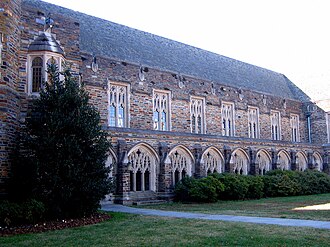
More than 400 student clubs and organizations operate on Duke's campus.[164] These include numerous student government, special interest, and service organizations.[165] Duke Student Government (DSG) charters and provides most of the funding for other student groups and represents students' interests when dealing with the administration.[166] The Duke University Union (DUU) is the school's primary programming organization, serving a center of social, cultural, intellectual and recreational life.[167] Cultural groups are provided funding directly from the university via the Multicultural Center as well as other institutional funding sources. one of the most popular activities on campus is competing in sports. Duke has 38 sports clubs, and 8 intramural teams that are officially recognized.[168] Performance groups such as Hoof 'n' Horn, the country's second oldest student-run musical theater organization, a cappella groups, student bands, and theater organizations are also prominent on campus.[169] The Duke University mock trial team won the national championship in 2012.[170] The Duke University Student Dining Advisory Committee provides guidance to the administration on issues regarding student dining, life, and restaurant choices.
Cultural groups on campus include the Asian Students Association, Blue Devils United (the student lesbian, gay, bisexual and transgender group), Black Student Alliance, Diya (South Asian Association), Jewish Life at Duke, Mi Gente (Latino Student Association), International Association/International Council, Muslim Student Association, Native American Student Coalition, Newman Catholic Student Center, Languages Dorm, and Students of the Caribbean.[164][171]
Civic engagement[edit]

According to The Princeton Review, Duke is one of 81 institutions in the country with outstanding community service programs.[172] In 2008 Duke received the Community Engagement Classification from Carnegie Foundation for the Advancement of Teaching.[173] In February 2007, Duke launched DukeEngage, a $30 million civic engagement program that allows undergraduates to participate in an in-depth service opportunity over the course of a summer or semester.[174] The program's scope has been called "unprecedented in U.S. higher education."[175] Duke students have created more than 30 service organizations in Durham and the surrounding area. Examples include a weeklong camp for children of cancer patients (Camp Kesem) and a group that promotes awareness about sexual health, rape prevention, alcohol and drug use, and eating disorders (Healthy Devils). The Duke-Durham Neighborhood Partnership, started by the Office of Community Affairs in 1996, attempts to address major concerns of local residents and schools by leveraging university resources.[176] Another community project, "Scholarship with a Civic Mission," is a joint program between the Hart Leadership Program and the Kenan Institute for Ethics.[177] Another program includes Project CHILD, a tutoring program involving 80 first-year volunteers; and an after-school program for at-risk students in Durham that was started with $2.25 million grant from the Kellogg Foundation in 2002.[178] Two prominent civic engagement pre-orientation programs also exist for incoming freshmen: Project CHANGE and Project BUILD. Project CHANGE is a free weeklong program co-sponsored by the Kenan Institute for Ethics and the Duke Women's Center with the focus on ethical leadership and social change in the Durham community; students are challenged in a variety of ways and work closely with local non-profits.[179] Project BUILD is a freshman volunteering group that dedicates 3,300 hours of service to a variety of projects such as schools, Habitat for Humanity, food banks, substance rehabilitation centers, and homeless shelters. Some courses at Duke incorporate service as part of the curriculum to augment material learned in class such as in psychology or education courses (known as service learning courses).[180]
Student media[edit]
The Chronicle, Duke's independent undergraduate daily newspaper, has been continually published since 1905 and now, along with its website, has a readership of about 70,000.[181] Its editors are responsible for selecting the term "Blue Devil". The newspaper won Best in Show in the tabloid division at the 2005 Associated Collegiate Press National College Media Convention.[182] Cable 13, established in 1976, is Duke's student-run television station. It is a popular activity for students interested in film production and media.[183] WXDU-FM, licensed in 1983, is the University's nationally recognized, noncommercial FM radio station, operated by student and community volunteers.[184][185]
Athletics[edit]
Duke University teams are known as the Blue Devils. They compete as a member of the National Collegiate Athletic Association (NCAA) Division I level (Football Bowl Subdivision (FBS) sub-level for football), primarily competing in the Atlantic Coast Conference (ACC) for all sports since the 1953-54 season.[186] Men's sports include baseball, basketball, cross country, fencing, football, golf, lacrosse, soccer, swimming & diving, tennis, track & field and wrestling; while women's sports include basketball, cross country, fencing, field hockey, golf, lacrosse, rowing, soccer, swimming and diving, tennis, track & field and volleyball.
Duke's teams have won 13 NCAA team national championships—the women's golf team has won five (1999, 2002, 2005, 2006, and 2007), the men's basketball team has won four (1991, 1992, 2001, and 2010), the men's lacrosse team has won two (2010 and 2013), and the men's soccer (1986) and women's tennis (2009) teams have won one each.[187]
In the past ten years, Duke has finished in the top 30 in the National Association of Collegiate Directors of Athletics (NACDA) Directors' Cup, an overall measure of an institution's athletic success. In 2011 Duke finished fifth in all of Division I and placed the best in the ACC,[188] while the athletic program finished tenth in 2010.[189] Duke has won 118 ACC Championships, 47 of which have come since 1999–2000 (through 2010–11), which is the second most in the ACC.[190] Duke teams that have been ranked in the top ten nationally in the 2000s (decade) include men's and women's basketball, men's and women's tennis, men's and women's soccer, men's and women's fencing, men's and women's cross country running, men's and women's lacrosse, women's field hockey, and men's and women's golf. Ten of these teams were ranked in the top ten in the country during the 2010–11 school year, while 17 were in the top 25.[191] The men's lacrosse program has proven successful, reaching the NCAA tournament semifinals in eight consecutive participating seasons from 2005 to 2013,[192][193][194][195][196] and winning national championships in 2010 and 2013.
The Blue Devil mascot's origins are rooted in an elite French alpine fighting unit that garnered accolades and much global attention during World War I and its aftermath for its flowing blue capes and blue berets.[197] Duke's mascot origin is considered to be military and patriotic rather than anti-religious.[197] Historically, Duke's major rival has been the Tar Heels of the University of North Carolina at Chapel Hill, especially in basketball. The rivalry has led the fanbases to identify the two differing shades of blue in relation to their respective university—calling the lighter powder blue "Carolina blue" and the darker blue "Duke blue".[198]
On the academic front, according to a 2006 evaluation conducted by the NCAA, Duke's student-athletes have the highest graduation rate of any institution in the nation.[199] From 2005 to 2010, Duke has placed in the top three every year (and finished first in 2005 through 2007) among Division I schools in the National Collegiate Scouting Association Power Rankings—a combination of the institution's Director's Cup standing, its athletic graduation rate, and its academic rank in U.S. News & World Report.[200][201][202][203][204][205] Duke led the ACC in Honor Roll inductees 23 out of the last 24 years through the 2010–2011 academic year.[206]
Men's basketball[edit]
Duke's men's basketball team is one of the nation's most successful basketball programs.[207][208] The team has captured four National Championships (fifth place all time), while attending 15 Final Fours (third place overall) and 10 Championship games (tied for second).[209] Duke has the most Atlantic Coast Conference championships, with 19, and has the most National Players of the Year in the nation, with 11.[210] Seventy-two players have been selected in the NBA draft, while 32 players have been honored as All-Americans.[211] Duke's program is one of only two to have been to at least one Final Four and one National Championship game in each of the past five decades.[212] The program's home facility is historic Cameron Indoor Stadium, considered one of the top venues in the nation.[213]
The team's success has been particularly outstanding over the past 30 years under coach Mike Krzyzewski (often simply called "Coach K"), who also has coached the USA men's national basketball team since 2006 and led the team to Olympic golds in 2008 and 2012, as well as World Championship gold in 2010. Their successes include becoming the only team to win four national championships since the NCAA Tournament field was expanded to 64 teams in 1985, 11 Final Fours in the past 25 years, and eight of nine ACC tournament championships from 1999 to 2006.[214]
Football[edit]
The Blue Devils have won seven ACC Football Championships, have had ten players honored as ACC Player of the Year (the most in the ACC),[186] and have had three Pro Football Hall of Famers come through the program (second in the ACC to only Miami's four). The Blue Devils have produced 11 College Football Hall of Famers, which is tied for the 2nd most in the ACC. Duke has also won 18 total conference championships (7 ACC, 9 Southern Conference, and 1 Big Five Conference). That total is tied with Clemson for the highest in the ACC.[215]
The most famous Duke football season came in 1938,[216] when Wallace Wade coached the "Iron Dukes" that shut out all regular season opponents; only three teams in history can claim such a feat.[217] That same year, Duke made their first Rose Bowl appearance, where they lost 7–3 when USC scored a touchdown in the final minute of the game.[216] Wade's Blue Devils lost another Rose Bowl to Oregon State in 1942, this one held at Duke's home stadium due to the attack on Pearl Harbor, which resulted in the fear that a large gathering on the West Coast might be in range of Japanese aircraft carriers.[218] The football program proved successful in the 1950s and 1960s, winning six of the first ten ACC football championships from 1953 to 1962 under coach Bill Murray; the Blue Devils would not win the ACC championship again until 1989 under coach Steve Spurrier.[219]
Duke has not had a winning football season since 1994, but has shown some signs of improvement in recent years.[220] David Cutcliffe was brought in prior to the 2008 season, and amassed more wins in his first season than the previous three years combined. The 2009 team won 5 of 12 games, and was eliminated from bowl contention in the next-to-last game of the season.[220] Mike MacIntyre, the defensive coordinator, was named 2009 Assistant Coach of the Year by the American Football Coaches Association (AFCA).[221]
While the football team has struggled at times on the field, the graduation rate of its players is consistently among the highest among Division I FBS schools. Duke's high graduation rates have earned it more AFCA Academic Achievement Awards than any other institution.[222]
In 2012, the football team became bowl-eligible for the first time since the 1994 season.
Alumni[edit]
Duke's active alumni base of more than 145,000 devote themselves to the university through organizations and events such as the annual Reunion Weekend and Homecoming.[223] There are 75 Duke clubs in the U.S. and 38 such international clubs.[224] For the 2008–09 fiscal year, Duke tied for third in alumni giving rate among U.S. colleges and universities according to U.S. News & World Report.[225] Based on statistics compiled by PayScale in 2011, Duke alumni rank seventh in mid-career median salary among all U.S. colleges and universities.[226] A number of alumni have made significant contributions in the fields of government, law, science, academia, business, arts, journalism, and athletics, among others.
Richard Nixon, 37th President of the United States graduated with a law degree in 1937.[227] Former U.S. Senator and Secretary of Transportation Elizabeth Dole,[228] 33rd President of Chile Ricardo Lagos,[229] former U.S. Secretary of Commerce Juanita M. Kreps,[230] congressman and three-time presidential candidate Ron Paul,[231] U.S. Secretary of Veterans Affairs and former Chief of Staff of the United States Army Eric Shinseki,[232] and the first United States Chief Performance Officer Jeffrey Zients[233] and Chairman of the Joint Chiefs of Staff Martin Dempsey are among the most notable alumni with involvement in politics and government.
In the research realm, Dr. Robert J. Lefkowitz, a Howard Hughes Medical Institute investigator who has spent his entire 39-year research career at the Duke University Medical Center, shared the 2012 Nobel Prize in Chemistry with Brian K. Kobilka of Stanford University School of Medicine, who was a post-doctoral fellow in Lefkowitz's lab in the 1980s. Duke graduates who have won the Nobel Prize in Physics include Hans Dehmelt for his development of the ion trap technique,[234] Robert Richardson for his discovery of superfluidity in helium-3,[235] and Charles Townes for his work on quantum electronics.[236] Other alumni in research and academia include Turing Award winners Fred Brooks[237] and John Cocke,[238] Templeton Prize winning physicist and religion scholar Ian Barbour,[239] MacArthur Award recipient Paul Farmer,[240] and former Dean of the Graduate School at Princeton Theodore Ziolkowski.[241]
Prominent journalists include talk show host Charlie Rose,[242] The Washington Post sports writer John Feinstein,[243] Chief Washington Correspondent for CNBC and The Wall Street Journal writer John Harwood,[244] CBS News President Sean McManus,[245] chief legal correspondent for Good Morning America Dan Abrams,[246][247] and CNN anchor and senior correspondent for The NewsHour with Jim Lehrer Judy Woodruff.[248] Basketball analysts and commentators include Jay Bilas,[249][250] Mike Gminski,[251] Jim Spanarkel,[252] and Jay Williams.[253] Magazine editors include Rik Kirkland of Fortune[254] and Clay Felker, founder of New York Magazine,[255] who died in 2008.
In the area of literature, William C. Styron won the Pulitzer Prize for Fiction in 1968 for his novel The Confessions of Nat Turner and is well known for his 1979 novel Sophie's Choice.[256] Anne Tyler also received the Pulitzer Prize for her 1988 novel Breathing Lessons.[257] In the arts realm, Annabeth Gish[258] (actress in the X-Files and The West Wing), Ken Jeong[259] (actor in The Hangover and Community), Randall Wallace[260] (screenwriter, producer, and director, Braveheart, Pearl Harbor, We Were Soldiers), Mike Posner[261] (singer, songwriter, and producer, Cooler Than Me, Please Don't Go) and David Hudgins[262] (television writer and producer, Everwood, Friday Night Lights) headline the list.
On the business front, the current or recent President, CEO, or Chairman of each of the following Fortune 500 companies is a Duke alumnus: Apple (Tim Cook),[263] BB&T (John A. Allison IV),[264] Boston Scientific Corporation (Peter Nicholas),[265] Chesapeake Energy (Aubrey McClendon),[266] Cisco System (John Chambers),[267] General Motors (Rick Wagoner),[268] JPMorgan Chase (Steven Black),[269] Medtronic (William A. Hawkins),[270] Morgan Stanley (John J. Mack),[271] Norfolk Southern (David R. Goode),[272] Northwest Airlines (Gary L. Wilson),[273] PepsiCo (Karl von der Heyden),[274] Pfizer (Edmund T. Pratt, Jr.),[275] The Bank of New York Mellon (Gerald Hassell),[276] and Wachovia (Robert K. Steel).[277] Kevin Martin was Chairman of the FCC,[278] and Rex Adams serves as the Chairman of PBS.[279] Another alumna, Melinda Gates,[280] is the co-founder of the $31.9 billion Bill & Melinda Gates Foundation, the nation's wealthiest charitable foundation.[281][282]
Management and ownership of professional athletic franchises include John Angelos[283] (Executive Vice President of the Baltimore Orioles), Aubrey McClendon[284] (partial owner of the Oklahoma City Thunder), John Canning, Jr.[285] (co-owner of Milwaukee Brewers), Danny Ferry[286] (former general manager of the Cleveland Cavaliers), Stephen Pagliuca[287] (co-owner of Boston Celtics), and Jeffrey Vinik[288] (owner of the Tampa Bay Lightning).
Finally, several athletes have become stars at the professional level, especially in basketball's NBA. Shane Battier, Corey Maggette, Elton Brand, Carlos Boozer, Luol Deng, Christian Laettner, Bobby Hurley, Grant Hill, Kyrie Irving and J.J. Redick are among the most famous.[289]
'North Carolina' 카테고리의 다른 글
| Vanderbilt houses (0) | 2014.05.20 |
|---|---|
| Asheville, North Carolina (0) | 2014.05.20 |
| University of North Carolina at Chapel Hill (0) | 2013.11.12 |
| North Carolina State University (0) | 2013.11.12 |
| Research Triangle Park (0) | 2013.11.12 |


